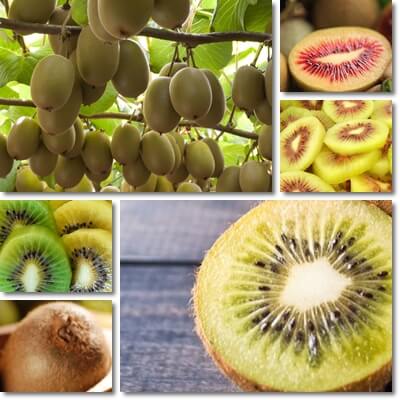Kiwifruit in a diabetic diet is generally well tolerated, but only in limited amounts. The fruit is a moderate source of carbohydrates, not too high in sugar and has good amounts of dietary fiber that can help with blood sugar control. But probably the most important way it benefits diabetes is by having a low glycemic index and glycemic load score. As a low-GI fruit, kiwifruit has limited glycemic effects and shouldn’t raise blood sugar levels by a lot, if consumed reasonably of course.
What is the glycemic index?
The glycemic index, GI for short, is essentially a numerical scale that measures how different foods affect blood sugar. More exactly, how fast the carbohydrates in a food raise blood sugar levels (because, during digestion, carbohydrates get broken down into sugar). Between 0-55 is a low GI. Between 56-69 is a moderate GI. Between 70-100 is a high GI. The lower the GI score of a food, the lesser it affects blood sugar. The higher the GI score, the more pregnant the effects.

What is the glycemic index of kiwifruit?
The glycemic index of raw, green and golden kiwifruit is typically over 50 and below 55, so a low score. However, individual fruits have been found to go as low as 47 or as high as 58 or even higher on the glycemic index scale. Despite the average GI score being in the 50-55 range, some fruits simply affect blood sugar more than others. This is, at least in part, owed to nutritional aspects such as carbohydrate content and profile which determine varied glycemic effects. If you are interested, I created a complete List containing the glycemic index of fruits.
What is the glycemic load?
The glycemic load, GL for short, is a numerical scale that measures how different amounts of a food affect blood sugar. More exactly, how fast the carbohydrates provided by a serving of a food raise blood sugar levels. Below 10 is a low GL. Between 11-19 is a moderate GL. Over 20 is a high GL. The smaller the serving/portion size of a food, the less carbohydrates you get to fuel the rise in blood sugar. The glycemic load basically says that most foods are okay to eat with diabetes if you practice portion control.
What is the glycemic load of kiwifruit?
Glycemic load values for different amounts of green and golden kiwifruit varieties:
- One green kiwifruit (estimated weight: 69 g): 5-6 (low GL)
- Two green kiwifruit (estimated weight: 138 g): 10-11 (moderate GL)
- 100 g of green kiwifruit: 7-8 (low GL)
- One cup of sliced green kiwifruit (180 g a cup): 13-14.5 (moderate GL)
- One golden kiwifruit (81 g per fruit): 6-7 (low GL) – Zespri SunGold variety
- 100 of golden kiwifruit: 8-9 (low GL)

How much sugar in kiwifruit?
How high in sugar is kiwi fruit? Here is how much sugar there is in different amounts of the fruit:
- 100 g of green kiwifruit has 8.99 g of sugar out of a total of 14.66 g of carbohydrates.
- One 2-inch kiwifruit with an average weight of 69 g has 6.2 g of sugar out of a total of 10.12 g of carbs.
- One cup of sliced kiwifruit, green variety, 180 g a cup, has 16.18 g of sugar out of a total of 26.39 g of carbs.
- 100 g of golden kiwifruit (Zespri SunGold variety) has 12.3 g of sugar out of a total of 15.79 g of carbs.
- One golden kiwifruit with an average weight of 81 g has 9.96 g of sugar out of a total of 12.79 g of carbs.
See also: Mango glycemic index
How to eat kiwifruit safely with diabetes
If eaten in large amounts at once, especially too frequently, kiwifruit can be one of those fruits that raise blood sugar levels. But if it’s consumed reasonably, then it has the potential to help with blood sugar control in diabetes. Here are some great tips type 2 diabetics especially can apply whenever eating fruits, whether kiwi or other kinds to limit their glycemic effects:
- Eat small amounts at once. One kiwi shouldn’t get you too many carbs (10.12 g of carbs for one fruit of the green variety, 12.79 g for the Zespri SunGold variety).
- Have one serving a day, at least until you have a clear idea of how a fruit affects your blood sugar and can adjust your diet/plan your meals to account for the carbs you are getting from multiple servings without compromising blood sugar control.
- Consider your individual reactions to a food and eat accordingly. Not all foods are good for everyone.
- Not on an empty stomach. Have kiwi or other fruits after a meal, preferably one lower in carbs.
- Pair with protein and maybe some fat. Nuts, seeds, lean meat, cheese, eggs are good choices to help reduce the impact of kiwi or other fruit on blood sugar.
- Choose the fresh fruit over its dried (possibly also sweetened) counterparts.
- Choose the whole fruit over the juice made from it. Juices exclude the fiber that helps with blood sugar control. They are often also sweetened which adds to their glycemic impact.
Is kiwifruit a low-glycemic food?
For the most part, yes, kiwi is low-glycemic with an average glycemic index (GI) score of 50 to 55. In some instances, the fruit is even lower on the GI scale whereas in others it’s higher. The fact that sometimes kiwi is higher on the glycemic index is not something unusual since a lot of fruits show some variation in GI values mainly as a result of differences in carbohydrate content and profile which determine different blood sugar effects.
Kiwi is also low-glycemic load, with a GL score of 5-6 and 6-7 per fruit pertaining to the green and the golden variety. Upwards of one green or golden kiwi or 100 g of either, it becomes moderate-glycemic load which means it has a more pregnant effect on blood sugar. It’s good to know that the low GI and GL values of kiwifruit mean nothing if it’s eaten in unreasonable amounts. Dietary excesses of any kind are best avoided if you want to manage a condition like diabetes both short and long-term.
